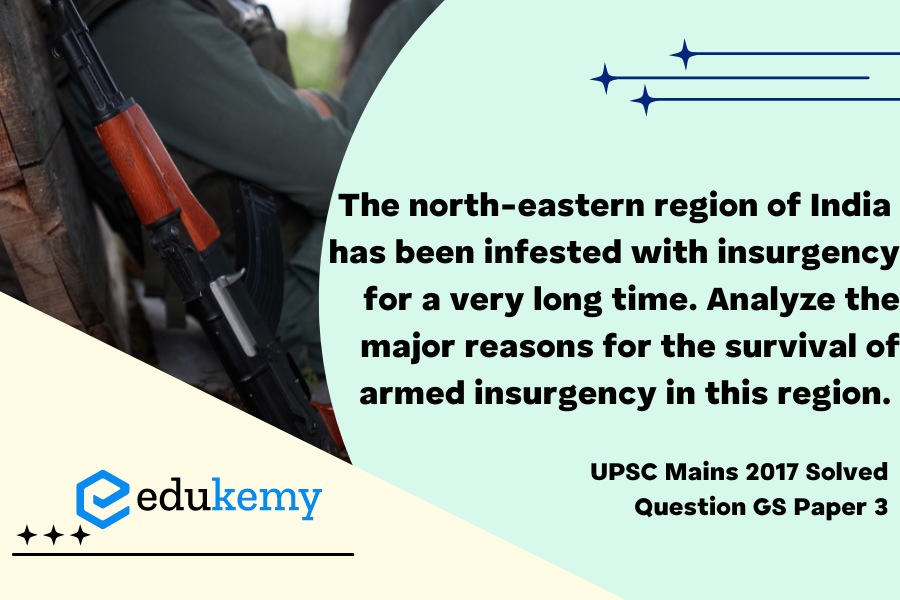The northeastern region of India has grappled with the persistent menace of insurgency, creating a protracted challenge that has endured for an extended period. This complex issue is deeply rooted in a myriad of socio-political, economic, and historical factors that have fueled the flames of armed conflict. The region’s diverse ethnic composition, historical grievances, economic disparities, and porous international borders have collectively contributed to the sustenance of insurgent movements. The intricate interplay of these elements has created an environment where discontent can find fertile ground, allowing insurgent groups to thrive. Examining the major reasons behind the enduring insurgency in the northeast becomes imperative to formulate comprehensive strategies for peace and development in the region. This analysis aims to shed light on the multifaceted nature of the problem, delving into the historical context and contemporary dynamics that have perpetuated the cycle of violence in this region.
Tag: Role of external state and non-state actors, in creating challenges to internal security. Security challenges and their management in border areas- linkages with organized crime with terrorism,
Contents
Decoding:
- In the Intro, try to write about the northeast region.
- In Body,
- Give the idea about recent insurgency trends in the northeastern region.
- Give an account of reasons for the survival of armed insurgency.
- Try to conclude with suggestions for peace and development.
Answer:
Northeast India is composed of eight states namely- Meghalaya, Manipur, Assam, Mizoram, Tripura, Arunachal Pradesh, Nagaland, and Sikkim. It is connected with the rest of India through the 22 km narrow “Siliguri Corridor” and it has strategic, political, and economic significance for India. A fact of greater disturbance in the region is the thriving militancy in most of the northeastern states. The demands of the different militant groups range from autonomy within the provisions of the Indian Constitution to outright secession.
Reasons for survival of insurgency in the northeast region. These are:

- This region has been one of the most neglected regions in terms of development and is the main cause behind the resentment of the people living in this area. The insurgent groups take advantage of the resentment of people and get a support base.
- Alienation of the population from the mainstream political process, where the insurgent group continues to boycott the dialogue and electoral process. (Ex – NSCN-Khaplang group)
- Hilly terrain, dense forests, and porous borders give strategic advantages for the insurgent guerrilla groups, and at the same time, it creates a big hurdle for counter-insurgency operations.
- Racial clashes are very common here due to the diverse racial profile of the region. In a fractured society, the insurgent groups penetrate easily.
- Active and covert foreign support to these insurgent groups, through training, logistic, and moral support has also been a big hurdle to eradicate these groups.
Recent Insurgency Trends: At one point, more than 120 militant groups operated in India’s northeast. In recent years, the Indian government has had some success in achieving stability in the region, using tactics from negotiations to military operations to root out militants. The 80% reduction in insurgency-related incidents and rise in the number of insurgents giving up arms by over 1600% from 2019 is a further improvement and a great achievement for the government and security forces.
The twin approach of development and counter-insurgency operations coupled with an honest political dialogue process may provide the best answer to the long-infested insurgency in the Northeast. The Government of India has taken various steps for insurgency reduction and development. Major insurgent groups are engaged in peace talks and this has raised hopes that there will be all-round peace and development in the region. Large-scale migration of youth from the Northeast to the mainland has also played a role in reducing the recruitment pool for insurgent groups. But still, insurgent activities are not eliminated.
In case you still have your doubts, contact us on 9811333901.
For UPSC Prelims Resources, Click here
For Daily Updates and Study Material:
Join our Telegram Channel – Edukemy for IAS
- 1. Learn through Videos – here
- 2. Be Exam Ready by Practicing Daily MCQs – here
- 3. Daily Newsletter – Get all your Current Affairs Covered – here
- 4. Mains Answer Writing Practice – here


